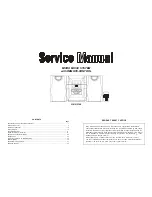
Since each channel contains several separate active units, d.c. blocking
capacitors are required at the interconnections. Many of these feed into resistive
potentiometer controls, the impedance of which has been limited to a maximum of
about 6k
Ω
in order to avoid excessive impedance at the slider. In order to avoid
clicks when the control is operated, it is necessary to use capacitors with very low
leakage currents. Hence, polyester and polycarbonate types have been selected.
Very large and bulky components would be required if the total bass loss of a
cassette were to be kept less than 0.1dB at 30Hz. Smaller capacitors are therefore
used and an adjust on test (AOT) resistor in the Band Pass Filter on each channel is
selected on test so that the bass rise of the filter before it begins to attenuate, just
balances the attenuation of the couplings.
In this way the response is kept substantially flat down to 30Hz. Below this
the Band Pass Filter cuts at 12 dB per octave and the coupling capacitors increase
this rate. The Band Pass Filter has a further A.O.T. resistor for trimming the overall
high frequency (20kHz) gain of each channel of each cassette.
2.4.8 Gain
In general, the gain of an active unit is determined by the ratio of two
feedback resistors, the forward gain being so high that it has a negligible effect. The
resistors employed are of the high stability type and their values are specified to
±
1%. The errors in the overall gain due to deviation of resistor values can be
cumulative and the unbalance of a pair of channels could be considerable of errors
were of opposite sign. This is overcome without the use of very close tolerance
resistors by providing one active unit in each channel of each cassette with an
A.O.T. resistor for setting the gain of that channel to the nominal value. This also
covers variations in the ratios of transformers, which are also specified to
±
1%.
The amplifiers in which the gain is trimmed are Amplifiers E, G and K. Some
channels have two separate amplifiers B. As it would not be economical to adjust
the gain of these, the gain determining resistors of these are specified to
±
0.5% to
ensure a balance of gain within 0.1dB between the channels.
When measuring gain of mixer channels, all inputs should be fed from a
200
Ω
source. All outputs have an impedance of about 200
Ω
and are designed to
feed a load of 2k
Ω
or greater. Thus a gain set with a 200
Ω
sending unit and a
bridging receive unit is required. For fault finding or for checking purposes it may be
necessary to measure the gain of an individual cassette. A cassette output, which
feeds a bus line, is intended to work into an amplifier C, which has a virtual earth
input. A test rig intended for this measurement is therefore provided with an
amplifier C3, which is similar to an amplifier C2, but with a feedback resistor with a
closer tolerance.
For testing a cassette having an Amplifier C at its input, a resistor of
6k8
±
0.5% is used to build out the Gain Set sending impedance to provide a current
source.













































